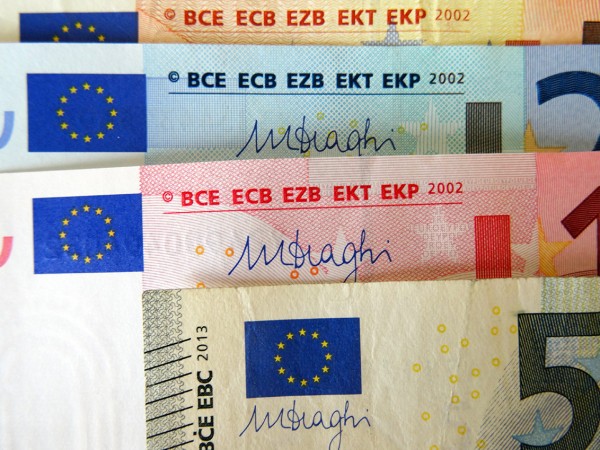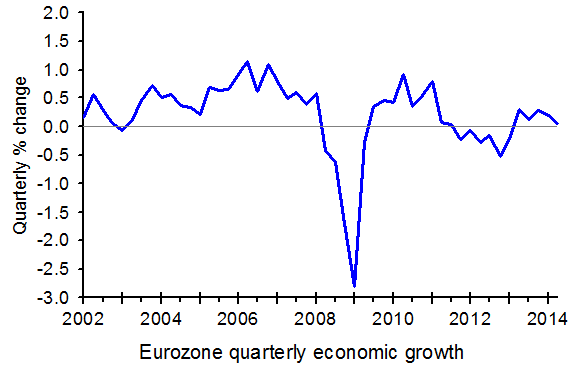 The eurozone recorded 0.0% growth in the second quarter of 2014. While the UK and USA are now experiencing relatively buoyant economic growth, the eurozone as a whole is stagnating. Some of the 18 eurozone countries, it is true, are now growing, including Spain, Portugal, Ireland and the Netherlands. But the German and Italian economies contracted in the three months to the end of June, while France experienced zero growth.
The eurozone recorded 0.0% growth in the second quarter of 2014. While the UK and USA are now experiencing relatively buoyant economic growth, the eurozone as a whole is stagnating. Some of the 18 eurozone countries, it is true, are now growing, including Spain, Portugal, Ireland and the Netherlands. But the German and Italian economies contracted in the three months to the end of June, while France experienced zero growth.
This will put growing pressure on the ECB to introduce quantitative easing (QE) through the direct purchase of government bonds or other assets. Although this has been a key policy of many central banks, including the Bank of England, the Fed and the Bank of Japan, up to now the ECB has focused mainly on providing cheap funds to banks to encourage them to lend and keeping interest rates very low.

In June, the ECB did announce that it would explore the possibility of QE. It would also introduce €400 billion worth of targeted long-term lending to banks (targeted longer-term refinancing operations (TLTROs)), and would cease sterilising the extra liquidity injected through the Securities Markets Programme, which involved the purchase of existing bonds on the secondary market.
These plans and their implications are examined in the blog post, The ECB: tackling the threat of deflation.
But even if it does eventually introduce QE, this is unlikely before 2015. However, the first €200 billion of TLTROs will be introduced in September and the remaining €200 billion in December. The ECB hopes that these measures in the pipeline will give a sufficient stimulus to rekindle economic growth. But increasingly there are calls for something more dramatic to be done to prevent the eurozone as a whole slipping back into recession.
Articles
Eurozone economy grinds to halt even before Russia sanctions bite Reuters, Michelle Martin and Martin Santa (14/8/14)
ECB under pressure to boost growth, analysts say BBC News (14/8/14)
Eurozone growth at zero as Germany slumps, France stagnates Deutsche Welle (14/8/14)
Eurozone crisis: The grim economic reality BBC News, Gavin Hewitt (14/8/14)
Eurozone growth splutters to a halt as crisis enters new phase The Guardian, Larry Elliott (14/8/14)
Eurozone can learn from George Osborne and Bank of England stimulus The Guardian, Larry Elliott (14/8/14)
Broken Europe: economic growth grinds to a standstill The Telegraph, Szu Ping Chan (14/8/14)
One-in-three chance the ECB conducts quantitative easing next year – Reuters Poll Reuters, Sumanta Dey (13/8/14)
Eurozone’s Unravelling Recovery: What’s Going Wrong Across Troubled Currency Bloc International Business Times, Finbarr Bermingham (14/8/14)
France calls on ECB to act as eurozone growth grinds to a halt The Guardian, Larry Elliott (14/8/14)
That sinking feeling (again) The Economist (30/8/14)
Data
GDP stable in the euro area and up by 0.2% in the EU28 eurostat euroindicators (14/8/14)
Statistics Pocket Book ECB
European Economy: links to data sources Economics Network
Euro area economic and financial data ECB
Questions
- Explain how quantitative easing works.
- Why has the ECB been reluctant to introduce QE?
- What is meant by sterilisation? Why did the ECB sterilise the effects of the assets purchased under the Securities Markets Programme? Why did it cease doing this in June?
- How have events in Ukraine and political reactions to them influenced the eurozone economy?
- Should QE be ‘fast tracked’? Would there be any dangers in this?
- What is the ‘Funding for Lending’ scheme in the UK? Is the planned introduction of TLTROs similar to Funding for Lending?
 The spectre of deflation haunts the eurozone economy. Inflation in the 12 months to May 2014 was 0.5%, down from 0.7% to April and well below the target of 2% (see). Price deflation can result in deflation of the whole economy. With the prospect of falling prices, many consumers put off spending, hoping to buy things later at a lower price. This delay in spending deflates aggregate demand and can result in a decline in growth or even negative growth: hardly a welcome prospect as the eurozone still struggles to recover from the long period of recession or sluggish growth that followed the 2007–8 financial crisis.
The spectre of deflation haunts the eurozone economy. Inflation in the 12 months to May 2014 was 0.5%, down from 0.7% to April and well below the target of 2% (see). Price deflation can result in deflation of the whole economy. With the prospect of falling prices, many consumers put off spending, hoping to buy things later at a lower price. This delay in spending deflates aggregate demand and can result in a decline in growth or even negative growth: hardly a welcome prospect as the eurozone still struggles to recover from the long period of recession or sluggish growth that followed the 2007–8 financial crisis.
The ECB is well aware of the problem. Its President, Mario Draghi, has stated on several occasions that the central bank will do whatever it takes to ward off deflation and stimulate recovery. At its monthly meeting on 5 June, the ECB Council acted. It took the following measures (see Mario Draghi’s press conference and the press release):
• The main refinancing rate it charges banks on reverse repos (when using open-market operations) was cut from 0.25% to 0.15%.
• The rate it pays banks for depositing money in the ECB was cut from 0% to –0.1%. In other words, banks would be charged for ‘parking’ money with the ECB rather than lending it.
• It will provide targeted lending to banks (targeted longer-term refinancing operations (TLTROs)), initially of 7% of the total amount of each banks’ loans to the non-financial private sector within the eurozone. This will be provided in two equal amounts, in September and December 2014. These extra loans will be for bank lending to businesses and households (other than for house purchase). The total amount will be some €400 billion. Substantial additional lending will be made available quarterly from March 2016 to June 2016.
• It will make preparations for an asset purchase scheme. Unlike that in the UK, which involves the purchase of government bonds, this will involve the purchase of assets which involve claims on private-sector (non-financial) institutions. Depending on financing arrangements, this could amount to quantitative easing.
 • It will suspend sterilising the extra liquidity that has been injected under the Securities Markets Programme (operated from May 2010 to September 2012), which involved purchasing eurozone countries’ existing bonds on the secondary market. In other words it will stop preventing the securities that have been purchased from increasing money supply. This therefore, for the first time, represents a genuine form of quantitative easing.
• It will suspend sterilising the extra liquidity that has been injected under the Securities Markets Programme (operated from May 2010 to September 2012), which involved purchasing eurozone countries’ existing bonds on the secondary market. In other words it will stop preventing the securities that have been purchased from increasing money supply. This therefore, for the first time, represents a genuine form of quantitative easing.
The question is whether the measures will be enough to stimulate the eurozone economy, prevent deflation and bring inflation back to around 2%. The measures are potentially significant, especially the prospect of quantitative easing – a policy pursued by other main central banks, such as the Fed, the Bank of England and the Bank of Japan. A lot depends on what the ECB does over the coming months.
The following articles consider the ECB’s policy. The first ones were published before the announcement and look at alternatives open to the ECB. The others look at the actual decisions and assess how successful they are likely to be.
Articles published before the announcement
Mario Draghi faces moment of truth as man with power to steady eurozone The Observer, Larry Elliott (1/6/14)
What the ECB will do in June? Draghi spells it out The Economist (26/5/14)
Draghi as Committed as a Central Banker Gets, as Economists Await ECB Stimulus Bloomberg, Alessandro Speciale and Andre Tartar (19/5/14)
ECB’s credit and credibility test BBC News, Robert Peston (2/6/14)
90 ECB decamps to debate monetary fixes Financial Times, Claire Jones (25/5/14)
Speech
Monetary policy in a prolonged period of low inflation ECB, Mario Draghi (26/5/14)
Articles published after the announcement
ECB launches €400bn scheme, seeks to force bank lending Irish Independent (5/6/14)
The ECB’s toolbox BBC News, Linda Yueh (5/6/14)
ECB’s justified action will help but is no panacea for eurozone deflationary ills The Guardian, Larry Elliott (5/6/14)
Why Negative Rates Won’t Work In The Eurozone Forbes, Frances Coppola (4/6/14)
Germany’s fear of QE is what’s stopping us from cracking open the Cava The Telegraph, Roger Bootle (8/6/14)
Data
Euro area economic and financial data ECB
Questions
- Why has the eurozone experienced falling inflation and a growing prospect of negative inflation?
- Explain how the Securities Markets Programme (SMP) worked (check it out on the ECB site). What countries’ bonds were purchased and why?
- What is meant by sterilisation? Why did the ECB sterilise the effects of the assets purchased under the SMP?
- If it is practical for the ECB to set a negative interest rate on the deposit facility for banks, would it be practical to set a negative interest rate for the main refinancing operations or the marginal lending facility? Explain.
- Why has the ECB, up to now, been unwilling to engage in quantitative easing? What has changed?
- Why may the introduction of a negative interest rate on bank deposits in the ECB have only a very small effect on bank lending?
- How much is broad money supply growing in the eurozone? Is this enough or too much? Explain.
- What else could the ECB have done to ward off deflation? Should the ECB have adopted these measures?
 The eurozone recorded 0.0% growth in the second quarter of 2014. While the UK and USA are now experiencing relatively buoyant economic growth, the eurozone as a whole is stagnating. Some of the 18 eurozone countries, it is true, are now growing, including Spain, Portugal, Ireland and the Netherlands. But the German and Italian economies contracted in the three months to the end of June, while France experienced zero growth.
The eurozone recorded 0.0% growth in the second quarter of 2014. While the UK and USA are now experiencing relatively buoyant economic growth, the eurozone as a whole is stagnating. Some of the 18 eurozone countries, it is true, are now growing, including Spain, Portugal, Ireland and the Netherlands. But the German and Italian economies contracted in the three months to the end of June, while France experienced zero growth.
